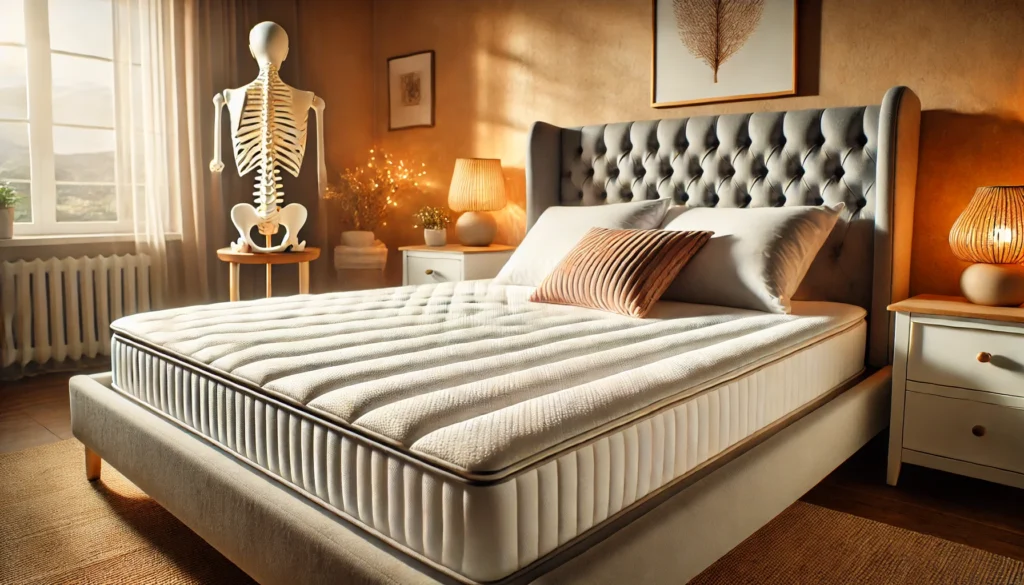Back pain can be caused by an unsupportive mattress, poor sleeping posture, or pressure points. A high-quality mattress pad adds an extra layer of comfort and support, helping to improve spinal alignment, relieve pressure, and enhance sleep quality.
Key Features to Look for in a Mattress Pad for Back Pain
When selecting a mattress pad to alleviate back pain, consider these essential factors:
- Material: Memory foam, latex, and fiber-filled pads provide enhanced support and comfort.
- Thickness: A thicker pad (2-4 inches) offers better cushioning and pressure relief.
- Firmness: Medium-firm pads help maintain proper spinal alignment.
- Cooling Properties: Gel-infused, breathable, or moisture-wicking materials help regulate temperature.
- Durability: High-quality construction ensures long-lasting support and comfort.
Read Also: COVID Back Pain: Causes, Prevention, and Recovery – Managing Back Pain During COVID!
Best Mattress Pad Materials for Back Pain Relief
- Memory Foam: Contours to the body, relieving pressure and supporting spinal alignment.
- Latex: Provides firm, responsive support with natural resilience.
- Gel-Infused Foam: Offers cooling properties while maintaining comfort.
- Down Alternative: A plush, hypoallergenic option for light cushioning.
- Wool or Cotton: Naturally breathable and temperature-regulating materials.
Top Recommended Mattress Pads for Back Pain

1. Tempur-Pedic TEMPUR-Adapt Mattress Pad
- Material: Memory foam
- Benefits: Excellent contouring and pressure relief
- Ideal for: Side and back sleepers
2. ViscoSoft Cooling Gel Memory Foam Mattress Pad
- Material: Gel-infused memory foam
- Benefits: Superior cooling and support
- Ideal for: Hot sleepers
3. Saatva Organic Mattress Pad
- Material: Organic cotton with plush filling
- Benefits: Breathable, hypoallergenic, and moisture-wicking
- Ideal for: Those who prefer a natural, eco-friendly option
4. ExceptionalSheets Bamboo Mattress Pad
- Material: Bamboo and plush down alternative
- Benefits: Soft, breathable, and pressure-relieving
- Ideal for: People looking for a cozy yet supportive feel
How to Choose the Right Mattress Pad for Your Sleeping Position
- Back Sleepers: A medium-firm memory foam or latex pad provides optimal support.
- Side Sleepers: A softer pad with pressure relief helps cushion the shoulders and hips.
- Stomach Sleepers: A firm pad prevents excessive sinkage and maintains spinal alignment.
- Combination Sleepers: A medium-firm, responsive pad adapts to various sleeping positions.
Additional Tips for Reducing Back Pain
- Maintain good posture while sleeping and sitting.
- Use a supportive pillow to keep the spine aligned.
- Stretch and strengthen core muscles regularly.
- Replace old, worn-out mattresses and pads.
Mattress Pad Lifespan: When to Replace for Optimal Support?
The lifespan of a mattress pad depends on its material and quality. High-quality memory foam and latex pads can last between 3 to 5 years, while lower-cost fiber-filled options may need replacement sooner. Signs of wear include sagging, loss of support, and visible indentations that impact comfort.
The Impact of Mattress Pads on Sleep Quality and Overall Health
A well-chosen mattress pad not only alleviates back pain but also improves sleep quality by minimizing pressure points and reducing tossing and turning. Proper spinal support enhances posture, reduces muscle tension, and promotes overall well-being.
Common Mistakes to Avoid When Buying a Mattress Pad for Back Pain
- Choosing the wrong firmness level for your sleep style
- Overlooking cooling features if you tend to sleep hot
- Buying a low-quality pad that loses support quickly
- Ignoring warranties and return policies
- Not measuring your mattress size before purchasing
FAQs:
1 What type of mattress pad is best for back pain?
Memory foam and latex mattress pads provide the best support and pressure relief for back pain.
2 How thick should a mattress pad be for back pain relief?
A thickness of 2-4 inches is ideal for cushioning and spinal alignment.
3 How often should I replace my mattress pad?
High-quality mattress pads last 3-5 years, but replace them if they lose support or show signs of wear.
4 Can a mattress pad make a firm mattress softer?
Yes, a plush mattress pad, like a down alternative or memory foam, can add softness while maintaining support.
5 Do cooling mattress pads help with back pain?
Yes, cooling pads with gel-infused foam or breathable materials help regulate temperature while providing support.
Conclusion:
A quality mattress pad can make a significant difference in reducing back pain and enhancing sleep comfort. Selecting the right material, thickness, and firmness ensures proper spinal alignment and pressure relief. Always consider your sleeping position and personal preferences to find the best mattress pad for your needs.
Read More Relevant Article:
- Read Also: Back and Body Hurts: Causes, Relief Tips, and Prevention – Experiencing Back and Body Pain!
- Read Also: Worst Sleeping Position for Lower Back Pain – Sleep Positions That Worsen Lower Back Pain!
- Read Also: Upper Back Pain During Pregnancy: Causes, Relief, and Prevention Tips – Managing Upper Back Pain During Pregnancy!











